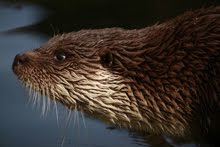A bird census yesterday took us well up in to the mountains south of Innsbruck, near Kühtai, where there is still some snow fields. The craziest thing is that these snow fields are now red.
yes, red!


It really is the bizarrest thing. The red is caused by a type of snow alga, called Watermelon Alga (Chamydomonas nivalis). It evidently favours cold situations, and the added light intensity of spring and summer cause great big blooms to spread out across the glacial and snow fields.
 not the most expansive or intense fields of watermelon alga I have seen, but nonetheless a stunning setting. the peak in the background is Acherkogel 3008m asl overlooking Oetz/Oetztal.
not the most expansive or intense fields of watermelon alga I have seen, but nonetheless a stunning setting. the peak in the background is Acherkogel 3008m asl overlooking Oetz/Oetztal.
Wayne Armstrong has a great article on watermelon alga / snow alga with lots of info if you are interested (quote from him):
Dale Forbes
yes, red!
It really is the bizarrest thing. The red is caused by a type of snow alga, called Watermelon Alga (Chamydomonas nivalis). It evidently favours cold situations, and the added light intensity of spring and summer cause great big blooms to spread out across the glacial and snow fields.
Wayne Armstrong has a great article on watermelon alga / snow alga with lots of info if you are interested (quote from him):
This unicellular organism is a member of the diverse green algae Division Chlorophyta (Order Volvocales), and contains a bright red carotenoid pigment in addition to chlorophyll. Unlike most species of fresh-water algae, it is cryophilic (cold-loving) and thrives in freezing water.Happy birding
Dale Forbes










.jpg)








.jpg)



7 comments:
Very interesting. I knew I'd heard of this, but now I know more. Algas are so adaptable. The setting is breathtaking. Thanks for sharing this Dale.
How extremely interesting Dale!! I would not think it could survive in those temps but it just goes to show how things adapt.
After I left the last comment on your original post, I wondered if it was not some mineral from the underlying soil which caused it.
I do love interesting facts like these. Thanks for sharing.
Joan, on this topic, our neighbour is a mycologist and her specific research focus at the moment is looking at alga that grow beneath glacial extensions and the regions bordering (and under) glaciers. it seems that this alga can continue to grow at temperatures of only 0.2°C even when under thick snow/ice.
absolutely fascinating. there is so much to learn here that i never even would have dreamed of having grown up in a subtropical land.
Gaelyn, apparently the Sierra Nevada mountains are famous for it going in to the summer. but you will have to get above 10,000ft to really see it. That will be a good hike indeed!
What a fascinating subject Dale. I cannot even begin to imagine what she finds under her microscope? A friend of mine loves studying these kinds of things and has shown me the most interesting stuff. It is a pity I do not know more on the subject. Does she have a blog? I know he would be interested in seeing anything she posts.
I will bet on you finding it a very different lifestyle there compared to here. It is one of the reasons I love it when people like you post bugs for me to compare. I think we find ourselves in a completely different environment, one we never knew exsisted. Yes, well maybe we did, but never thought about much it.
Although I know Innsbruck and the Tirol earonably well, I've never been above the snow-line in the summer.
Veru interesting phenomenon, and thanks for the information on this cold spasific fungus.
I don't know much about snow, leave alone snow algae but I can confidently say that the last image is a spectacular snowscape shot. Stunning actually.
thanks Thomas, it was such a stunning setting and we had been walking for a good 4hours-ish already so it really was rather hard to think about taking photos instead of just soaking in the splendor and staring about in disbelief at the setting.
Post a Comment